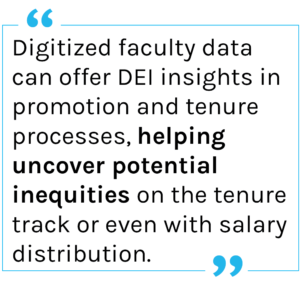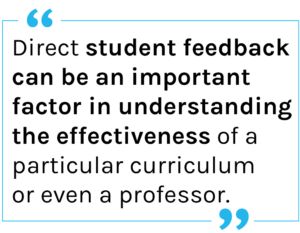
Your faculty take on many different roles and are a vital part of your institution.
But many colleges and universities don’t have systems in place for understanding faculty workloads, teaching effectiveness, research burdens, and service commitments. A PeopleAdmin survey found that 48 percent of HigherEd institutions still use paper processes for their faculty, which means they’re missing out on vital insights. Digitizing faculty systems unlocks countless data analytics that could impact strategic decision-making. Read on to learn more about what you could learn when you embrace digitization for faculty.
DEI Insights
Diversity, equity, and inclusion (DEI) in the workplace is front and center in the national conversation. At the faculty level, there is a lot your data can tell you about DEI and the success of your DEI initiatives. For instance, the burden of service work often falls disproportionately on female faculty members, as well as on other underrepresented groups. However, self-reported information about service work isn’t always reliable: faculty often don’t have a sense of how much service work they should be doing, or how much they’re doing in comparison with others—meaning that it’s hard for academic affairs leaders to get a good read on the distribution of service work.
With digitized faculty information, however, academic leaders can access on-demand, real-time dashboards that show breakdowns of faculty activities by role, department, or school, including EEO information. This allows your institution to remove bias in service requests and assignments, and ensure that no one is taking on an unequal share of service (which usually means sacrificing other faculty duties, like research).
Digitizing faculty data can offer DEI insights in other areas as well, including promotion and tenure processes, helping uncover potential inequities on the tenure track or even with salary distribution. To truly take action on DEI in the HigherEd workplace, your team needs to have all the information available—and that means a centralized, digital faculty information system.
distribution. To truly take action on DEI in the HigherEd workplace, your team needs to have all the information available—and that means a centralized, digital faculty information system.
Research and grants
Research (and the grant writing that goes along with research) is often a core part of a faculty member’s role. How can you ensure that they’re devoting enough time to their research—and that they’re using their time effectively? Digitized faculty information, which includes faculty dossier, research history, and grant history, can help academic affairs leaders and deans know at a glance how many papers a faculty member has published, what projects they’re working on, or what conferences they’ve spoken at recently. This visibility can help administrators see who might need more support or time—for instance, female faculty published fewer research papers in 2020 and 2021 than their male counterparts. Women reported an increase in workload and in caregiving responsibilities during that time period. With insight into faculty research activities, your institution could pinpoint faculty members who need to reduce their teaching or service burdens to tackle their research needs, or find ways to offer more support to faculty who are being impacted by external events.
Curriculum effectiveness and student outcomes
Another aspect of faculty duties that can be difficult to track and understand is teaching effectiveness. Connecting faculty activity with student outcomes can be difficult, but digitization is an important first step. When every course a faculty member has taught is in one centralized system, you can begin to connect those courses with curriculum information, and then with the students who were in those classes, and then with student outcomes. PeopleAdmin’s partnership with Enflux provides actionable insights to optimize curriculum and support faculty in their teaching efficacy, all to increase student success.
 It’s also vital to tie in course evaluations and student surveys with faculty activity. Direct student feedback can be an important factor in understanding the effectiveness of a particular curriculum or even a professor. PeopleAdmin’s innovative product team will soon be launching a brand new way for faculty and student voices to be heard and for academic affairs leaders to access vital course insights. Check out our on-demand sessions from PeopleConnect Live 2022 for more!
It’s also vital to tie in course evaluations and student surveys with faculty activity. Direct student feedback can be an important factor in understanding the effectiveness of a particular curriculum or even a professor. PeopleAdmin’s innovative product team will soon be launching a brand new way for faculty and student voices to be heard and for academic affairs leaders to access vital course insights. Check out our on-demand sessions from PeopleConnect Live 2022 for more!
Final thoughts
Faculty activity information can be a rich source of insights for your institution—but many colleges and universities are leaving that data untapped. Digitizing faculty data can be transformative, not just for the faculty themselves, but for students, deans, and the entire institution. Don’t wait to digitize.